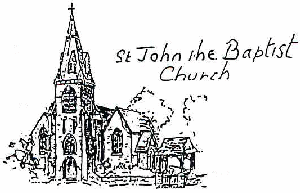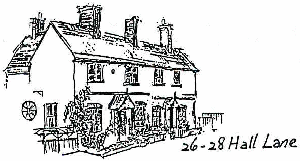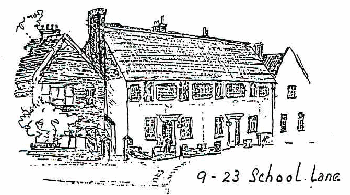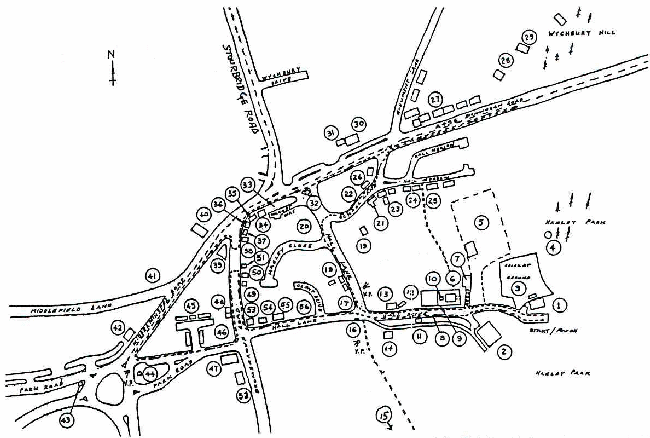WALKS AROUND HAGLEY: WALK No.4 OLD HAGLEY
DISTANCE: ONE & A HALF MILES. TIME: MINIMUM 1 HOUR. PARK: BY PARISH CHURCH (O.S. MAP GRID REF) 921802
 R. The present Church buildings are mainly Victorian, 1857-1860. Designed by G.E. Street in 13th. century style, but on ancient site. Worth a visit.
R. The present Church buildings are mainly Victorian, 1857-1860. Designed by G.E. Street in 13th. century style, but on ancient site. Worth a visit.- L. Hagley Hall. Palladian mansion built 1754-1760. Designed by Sanderson Miller for Sir (later Lord) George Lyttelton.
- R. Cricket pitch, site of the original half-timbered Hall. The old main road to Birmingham reputedly ran between the Old Hall and the Church before the present Birmingham Road was turnpiked in c.1753.
- Look back R. to the "Prince's Pillar", commemorating Frederick, Prince of Wales, son of George Il. Sir George Lyttelton was Frederick's Secretary 1730 - 1740's.
- Private Gardens of the Hall.
- Turn R. to Stables, built 1940's. Conversions to workshops etc. 1984. Inside courtyard note Clock dated 1951; Weather Vane; 2 original iron Lantern Holders; Cobbles.
- Car park is the site of 18th. century Laundry, pulled down 1957. Small Temple to rear originally a Summer House, containing stained glass windows illustrating "The Seasons" by 18th. century poet James Thomson.
- Return to Hall Drive. Wall on L. is the Ha-Ha (or sunken fence) to the garden in front of the Hall.
- R. The pointed window in the Stable-block wall marks the Hall Barn, formerly used as a Church Social Room. Note ventilation holes of the Barn
- R. Look up to attractive Lantern tower supporting Weather Vane, Walls show signs of conversions
- L. Ice House. Domed brick construction. Before refrigeration, ice used in the hall would have been kept here. (Overgrown in Summer)
- R. The Cot: probably servants cottage to:-
- Park House (no nameplate). Possibly late 18th. century. A listed building with nice decorative ironwork to the porch. Former Rectory, 1949-1979.
- L Modem Lodge to the Hall. Notice the remains of the avenue of trees in the field (some felled in 2000) leading up from the Bromsgrove Road to the Lodge, alongside the present road. Turn L. for a short way along the footpath to Clent. V. P. for views of Malvern/ Abberley/ Clee Hills.
- Hedge marks Parish boundary. Return to Lodge.

- Drinking fountain. Cast iron, marked "J. Kennedy Patentee", possibly older than the brickwork which is dated 1914. Turn into section of Hall Lane which runs towards the Birmingham Road. Walk for a short distance to: V. P. for view of the Obelisk (some dispute as to who erected this either Admiral Smith or Sir Richard Lyttelton) and the Temple of Theseus, 1758, first of its kind in the 18th. century English Landscape Park.
- L. Modern ElI Pillarbox (Square locked box to house excess postbags during deliveries).
- Complex of 18th. century cottages. Note "Sun" Fire Insurance Plaque on No. 28.
- R. Scout Hut opened May 1978 on former site of allotments to School in School Lane.
- L. Site is marked "Hop Meadow" on 1837 Tithe Map.
- R. 18th. century building: remains of Bostin's Butchers Shop and Premises. Much altered.
- L. "Old Coach House" possibly 18th. century.
- R. Row of 18th. and 19th. century houses and small courtyard of cottages. Possibly at least one "Ale House" here originally.
- Continue R. into Hall Meadow. A. Site of School built by Lord Lyttelton 1827, now occupied by 2 modem houses. The path at the side leads back across Hall Meadow to the Stables and Hall.
- R. Some Lyttelton Estate houses amongst more recent housing development.

- Return to School Lane. "The Hurst" Interesting Victorian house, enlarged at some time, now divided. Continue along School Lane to Birmingham Road. Turn R. up hill to a point opposite Monument Lane.
- Small cottages probably housed servants to the larger mansions. Next 4 houses, 2 semis and 2 detached, are all listed Grade II buildings. Late 18th or early 19th. century. Note G. R. pillarbox in the wall.
- Behind shrubbery, "The Lawns" c. 1840's, A former Rectory prior to "Park House" in Hall Drive.
- Elm Lodge, used for a time as a private School. 1980's reconstructed facade. Original early 19th. c.
- Return down hill to opposite "Rockingham Hall". Former Dower House. Original building late 16th. early 17th. century. Several periods of alteration and extension in the 18th. 19th. and 20th. centuries. Now divided into flats.
- The Orangery, now 2 houses, once part of Rockingham Hall Estate.
- L. Cottage on the triangle of land, reputedly built from the same stones as the present St. John's Church (1850's).
- L. Site of the old Cattle market. Used till 1950's.
- L. "The Spensers Arms". On site of an Inn named to commemorate marriage of Wm. Henry (later 3rd. Lord) Lyttelton to Sarah Spenser in 1813.
- L. Old cottages converted to shops. The General Stores is the present Hagley Post Office.
- Pair of cottages, possibly 18th. century Blacksmith's house.
- Walk a short way into Bromsgrove Road. L. Pair of early 20th. century cottages.
- Former Police Station built 1930's. Return to the main road.
- The Garage Showroom is the site of the old village Forge. The road .here was once Middlefield Lane, becoming part of Kidderminster Road in the 1920's when a new section was constructed to intersect Park Road.
- R. Telephone Exchange. Note ultra-modern signalling equipment.
- R. Start of present day Middlefield Lane.
- R. Modern Police Station to replace the one in Bromsgrove Road.
- Bear L. at large island, feeder road to M5 built 1964, note War Memorial opposite.
- L Memorial commemorating the Grazebrook Diamond Wedding 1905. Originally sited in the centre of the cross roads near the Cattle Market. V.P. Views to Malvern, Abberley & Clee Hills.
- Turn L. to upper part of Park Road. L. Council houses c. late 20's and 30's.
- Site of the Lyttelton Arms Stables.
- R. Lyttelton Arms, now a Harvester Restaurant, variety of periods from the 18th. century onwards. Old Coaching Inn, known locally as "The Taphouse".
- Turn L. into Bromsgrove Road a short way. L. the old Post Office was at No 20.
- R. No 29 Lea Cottage, home of a 19th. century village Infants' School, Mistress Mrs. Wooldridge, wife of the Blacksmith at the Forge.
- R. No. 25 originally a Workingmen's Institute, since converted into a house.
- R. No 23 Former Infants' School, 1856 - 1937.
- Return to the cross roads. Below the Harvester Restaurant is Beacon Hill House, 18th. century.
- Turn L. into Hall Lane (Once known as Park Lane). The house on the corner was originally a shop, 18th. century.
- L. Furlong Cottage, note barge boards, decorative tilework and drip mouldings. Probably added mid-19th. century in revival style.
- Highbury Cottage, square shaped extension was built in double cube proportions in 1930's. Rest of the frontage appears to be 18th. century, original building late 16th or early 17th. century.
- No. 48 occupies the site of a Malthouse on the 1837 Tithe map which was used for brewing by the Lyttelton Arms. The Malthouse was built as a Glasshouse to manufacture bottles in the late 17th. century by Paul Tyzack II and John Pagett. Return up Hall Lane then Hall Drive to the Church
 1
1
